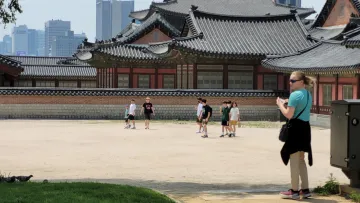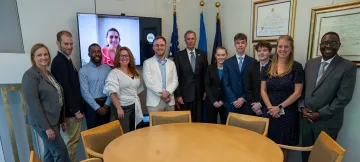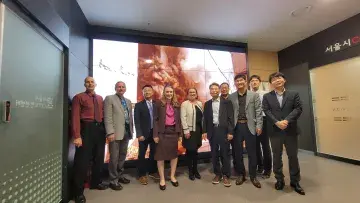This summer, the Science & Technology Directorate (S&T) was pleased to host 28 interns from colleges and universities across the country. By applying knowledge learned in the classroom to real world problems, students were able to make valuable contributions to national security, strengthen our cyber defenses, and help protect the nation from rising threats. These talented students, representing a variety of educational backgrounds, were sponsored by S&T’s Homeland Security Professional Opportunities for the Student Workforce to Experience Research (HS-POWER) internship program.

HS-POWER—a 10-week program for undergraduate and graduate students in a broad spectrum of science, technology, engineering, and mathematics (STEM) disciplines and Department of Homeland Security (DHS) mission-relevant research areas—helps students build and foster lasting relationships with researchers, DHS personnel, and academic facilities. Students are paired with mentors experienced in their fields, providing each with an interesting and unique learning experience. Mentors advise students on their individual research projects and teach them how to address current issues facing our nation and how to develop new solutions for future challenges.
“These students are the next generation of our Homeland Security and federal government workforce, and HS-POWER gives them hands-on opportunities to cultivate critical skills, make important connections, and really just immerse themselves in experiences not found in classrooms,” said Rebecca Medina, Director of S&T’s Office of University Programs. “They broaden their knowledge while also making valuable contributions to pressing homeland security issues.”
The work of Nicole Fernandez Tejero, a PhD student from Florida International University, is a wonderful example of the ways in which HS-POWER interns can substantively contribute to the DHS mission. Nicole analyzed methods and strategies used by various groups to address the difficult problems posed by invasive species, animal diseases, and pests. More specifically, she looked into the use of artificial intelligence (AI) for real-time global data analysis to recognize patterns or anomalies, the use of environmental DNA for biomonitoring, the application of disinfection and decontamination processes at border ports of entry, mobile applications for inspections and identification, and the research into electronic noses for detection, that could augment the use of canines.
“Nicole’s research actively helped S&T engage with new partners in Australia and New Zealand, which has resulted in plans for a new agreement to formalize collaborations in agricultural security with these two nations,” said Emily Saulsgiver of S&T’s International Cooperative Programs Office (ICPO).
Another HS-POWER intern had the opportunity to work with our partners abroad. Brooke Cochran, a biomedical engineering major at Michigan Technological University, traveled to the Republic of Korea with ICPO to investigate different approaches to COVID-19 response in the United States and the Republic of Korea. Brooke researched public health data collection structures, national versus state-led data collection, and ultimately explored how both countries will continue to consider ongoing COVID-19 findings to better prepare for a next pandemic.

Rebecca Chausse, a public health major at Yale University, worked on two projects. First, Rebecca compiled gaps and recommendations for Terrorism Community of Interest Evaluations; as a result of her work, a set of three recommendations were developed that will help to close gaps related to the Department’s terrorism prevention evaluation work. She then worked on developing a framework based on gaps identified in the Enhanced Pandemic Response Working Group. “The goal of the framework was to better contextualize and operationalize the Department’s preparedness and response posture to future potential pandemic threats,” said Ross Owens with the Technology Centers Division (TCD) in S&T’s Office of Science and Engineering (OSE).
Some interns had the opportunity to work together. Stefano Chiaradonna, an applied mathematics major from Arizona State University, and Kyle Stein, an intelligent systems and robotics major from the University of West Florida, identified technical challenges that could be abstracted into general problems that researchers from various National AI Research Institutes could tackle. The 25 AI Institutes, funded by the National Science Foundation, S&T and other federal agencies, as well as leading industry partners, are a nation-wide research ecosystem that tackles societal and economic challenges by advancing foundational AI research. Distilling chronic challenges across the enterprise related to AI and machine learning, and communicating them to these research teams, helps S&T connect academic experts with needs at the front line.
“Kyle and Stefano took the lead on distilling the problems discussed by the group and developing a presentation to communicate them clearly and effectively to academic researchers,” said TCD-OSE’s Dr. Sean Warnick, who served as an S&T mentor for both students. “Our hope is to not only share them with the AI Institutes, but more broadly, including with our department.”
Individually, Stefano looked at an open mathematical problem identifying the structure of a feedback system that will minimize its intrinsic vulnerability.
“While it is well known that removing internal feedback loops can inoculate systems against destabilization attacks, feedback systems, such as those necessary for most critical infrastructure systems such as power grids or municipal water systems or chemical processing plants, require feedback control as a mechanism to achieve reliable functionality,” Warnick said. “For these systems, it is unclear how the designed feedback control should be implemented, and Stefano’s work will act as a guide to understanding which structures are intrinsically more vulnerable.”
Cyber defense and deep fake and digital forgery technologies are some of the other issues interns worked on. Qaylin Holliman, a computer science major at North Carolina A&T State University, explored ways that cyber-attacks are delivered in today’s complex technological environment.

“His work takes a hard look at the ways cyber criminals are delivering their attacks of all flavors, helping us understand the trend for innovations (or lack of innovation) in the area and how to better protect against them,” Warnick said.
Carter Naughton, a computer science major at the University of Georgia, worked on understanding the current state of deep fake and digital forgery technologies. “Carter not only explored new methods emerging for distinguishing AI generated content or digital forgeries from original content, but he thought hard about how society changes when we reach the point where generative AI is so effective that traditional approaches for identifying fakes fail,” added Warnick.
Completing a survey of Test and Evaluation (T&E) was one of Camille Holley’s primary responsibilities during her internship experience. Camille, a mechanical engineering major at the University of Memphis, met with S&T’s Test and Evaluation Division (TED) Deputy Directors and discussed their portfolio of programs and the associated testing. “Ms. Holley realized that T&E may be a viable career path for professionals early in their career, so she investigated how personnel typically enter the field by meeting with T&E professionals across DHS, as well as the Department of Defense and industry,” said TED’s Adam Martin, who served as Camille’s mentor. “These interactions led her to realize that there are significant barriers for a younger professional to enter the T&E field, so she co-authored a paper with Ms. Natalie Heinrich, a fellow DHS Student Workforce program intern from the Virginia Polytechnic Institute and State University, on ways to attract people to the T&E profession early in their career; this paper will be submitted to the International Test and Evaluation Association for publication in their professional journal.”

Rithi Valluri, a neuroscience major at the College of William & Mary, gathered data to support the Transportation Security Administration’s security strategy to reduce false alarms generated by Explosive Trace Detector equipment during secondary screening at airport checkpoints. Rithi assessed nuisance alarms caused by benign (harmless) objects and conducted a characterization study at S&T’s Transportation Security Laboratory (TSL). She collected measurement data using laboratory instrumentation to ascertain nuisance alarm rate (false positives) to determine which commonly occurring objects are causing false alarms and reviewed spectrogram data to identify if specific ingredient(s) within a commodity is the source of the false alarm. “In the future, the data set would have to be expanded to be representative of passenger stream of commerce and could potentially support machine learning algorithm development to clear the nuisance alarm(s) and conduct trade-off studies between false alarm and detection performance,” said Jagdeep Talwar of S&T’s Office of Innovation and Collaboration, and who served as Rithi’s mentor.
S&T’s 2023 HS-POWER interns’ contributions to projects that are critical to our nation’s security was both impressive and valuable. “The hands-on experience that they walk away with will benefit them in their future career endeavors,” said Medina.
Not only does the program benefit students, but it also has many advantages for the Directorate. “Students’ meaningful research contributions helps advance S&T’s research efforts. We benefit from the unique experiences and backgrounds that each student brings to the work. Their new and fresh perspectives help lead to new and innovative solutions to some of our nation’s most pressuring issues. HS-POWER benefits both the student and the Directorate.”
For more information on HS-POWER, visit the ORISE STEM Internships and Fellowships page. We introduced each of the student interns this summer in S&T’s Instagram Stories (@dhsscitech)—view our ‘Internships’ highlight to learn more about them. For related media inquiries, contact STMedia@hq.dhs.gov.
